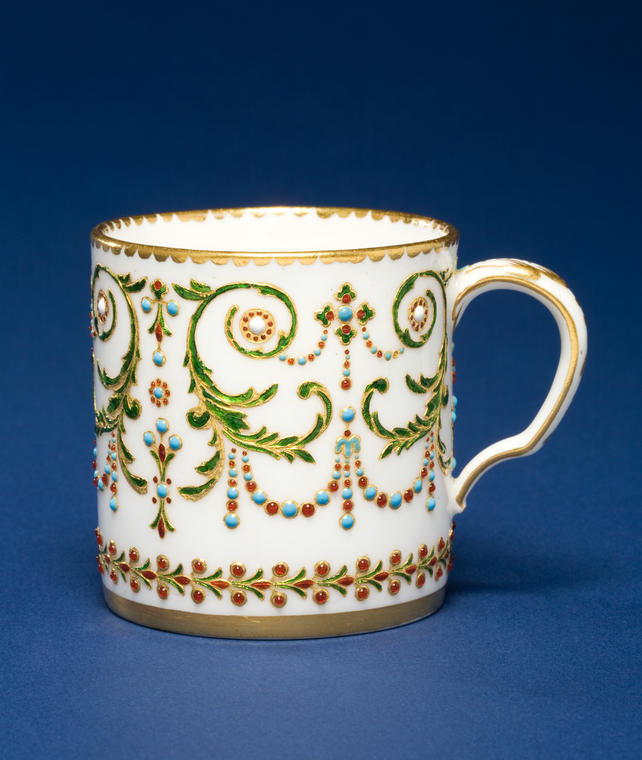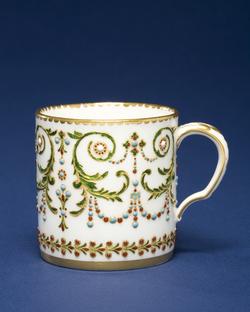Current Location: In storage
Titles
Gobelet litron
Maker(s)
Factory:
Sèvres Porcelain Manufactory
Gilder:
Prévost, Jean Louis
(Uncertain)
Entities
-
Cup
- Factory name: gobelet litron
- Category: teaware
Categories
Description
Soft-paste porcelain cup, decorated with gold paillons and jewelling in translucent and opaque enamels
Soft-paste porcelain, decorated with gold paillons and with translucent green, and red, and opaque turquoise and white enamels. Cylindrical cup with an arched and incurved loop handle. The upper part of the cup is decorated with alternately facing and backing green foliated scrolls, linked by swags of red and turquoise blue 'jewels' and separated by stylised flowers and leaves. The lower part is decorated by a border of paired berries with stylised buds between them. There is a band of gilding round the lower edge, a dentilated band round the rim, gold lines down the sides of the handle which has a large leaf and two small trilobate leaves separated by dots of graduated size down its back.
Notes
History note: Louis C.G. Clarke, MA, Leckhampton, Cambridge
Legal notes
L.C.G. Clarke Bequest, 1960
Measurements and weight
Height: 5.8 cm
Acquisition and important dates
Method of acquisition: Bequeathed
(1960)
by
Clarke, Louis Colville Gray
Dating
18th Century, Late-19th Century, Mid
Production date:
AD 1784
Note
Eighteenth-century jewelling on Sèvres porelain was often executed with blue ground colour or other darkish colours, but there are examples with a white ground. For example, two juice pots, one with cover, jewelled in green, red, and turquoise on a white ground gilded by Vincent (2000), and dated to c. 1780 and are in the Hermitage. (See Documentation Birioukova and Kasakevitch, 2005), A milk jug in the British Museum, also with 2000 gilder’s mark, is described as 18th century, with decoration later, probably late 19th century. (see Documentation, Dawson, 1994). It is possible that this cup was decorated in the 19th century. A miniature gobelet litron with decoration very close to that on the Fitzwilliam's cup is at Haughton, Norfolk.
Jewelled enamelling is recorded as being introduced by Philippe Parpette, a flower painter at the factory, and Joseph Cotteau, an Parisian enameller in 1778. Parpette worked mainly on this type of decoration between 1780-5. The latter left the factory in 1784, and after 1786 this type of decoration was rarely executed. The jewelled decoration was created by placing drops of translucent or opaque enamel over gold foils of different shapes formed by steel dies, and firing them so that they fused. The motif was then attached to the porcelain by an enamel and fired again at a lower temperature. This technique had been used much earlier on silver foil on early 16th century Limoges enamels on copper, and was also used, somewhat differently to create jewel effects on gold snuffboxes. The designs were usually by J.-B.-E. Genest, head of the artists’ studio, and the steel dies were made by the Parisian engraver Jean-Pascal Le Guay (see Documentation, Bellaigue, 1979)
The gobelet litron was named after a cubic measure, the litron, which was normally made of wood, and was used for dry stuffs, such as corn and peas. Its size in Paris had been defined in 1670 as the equivalent of 9.45 cm high and 10.15 cm in diameter in pouces and lignes, which was larger than the largest of the porcelain cups. The first size of gobelet litron had been introduced at Vincennes before October 1752 when it was mentioned in an inventory of stock, but was probably being made earlier.The second and third sizes followed in 1753, and the fourth and fifth in 1757. They could be fitted with one of seven different handle forms . A drawing in the archives at Sèvres is dated 19 February 1753 (MNS, R1, liasse 2, dossier 2, No. 6bis) They were supplied singly, singly with a plateau carré, in ’harlequin’ sets, or as part of matching dejeuner. (See Documentation, Savill, 1988, Bellaigue 2009,)
This is a gobelet litron of the third size with Savill's handle shape B.
When inventoried by Sotheby’s in October 1948, the gilding was attributed to Henry-Martin Prévost, but the joined form of the HP or IP is not similar to his mark.
School or Style
Louis XVI
Components of the work
Decoration
composed of
enamels
gold
Rim
Diameter 5.5 cm
Including Handle
Width 7.6 cm
Materials used in production
Lead-glaze
Soft-paste porcelain
Techniques used in production
Moulding
: Soft-paste porcelain decorated with gold paillons and with green, orange-red, turquoise and white enamels.
Lead-glazing
Inscription or legends present
- Text: interlaced L's enclosing 99
- Location: On base
- Method of creation: Painted in faded gold
- Type: Factory mark
Inscription present: IP joined together by the arc of the P, or HP with second stroke of H and P having same stroke
- Text: IP or HP monogram
- Location: On base
- Method of creation: Painted in gold
- Type: Gilder's mark
- Text: 41
- Location: On base
- Method of creation: Incised
- Type: Incised mark
References and bibliographic entries
Identification numbers
Accession number: C.56-1961
Primary reference Number: 86622
Stable URI
Audit data
Created: Saturday 6 August 2011
Updated: Tuesday 12 January 2021
Last processed: Thursday 14 August 2025
Associated departments & institutions
Owner or interested party:
The Fitzwilliam Museum
Associated department:
Applied Arts

 IIIF Manifest
IIIF Manifest




